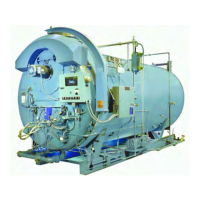Chapter 3 — Waterside Care and Requirements
3-4 Part No. 750-184
If care is not taken to ensure adequate or proportional flow through
the boilers, wide variations in firing rates between the boilers can
result.
In extreme cases, one boiler may be in the high-fire position while
the other boiler or boilers may be at low fire. The net result would
be that the common header water temperature to the system would
not be up to the desired point.
Pump Location - It is recommended that the system circulating
pumps take suction from the outlet connection on the boiler, and
that they discharge to the system load. In order to put the boiler and
the expansion tank on the suction side of the pump. The suction
side is preferred because it decreases air entry into the system and
does not impose the system head on the boiler.
It is common practice to install a standby system circulating pump.
The main circulating pumps are usually located adjacent to the
boilers in the boiler room.
Pump Operation - Pumps are normally started and stopped by
manual switches. It is also desirable to interlock the pump with the
burner so that the burner cannot operate unless the circulating
pump is running.
Pressure - The design of the system and usage requirements often
dictate the pressure exerted upon the boiler. Some systems are
pressurized with air, or with an inert gas such as nitrogen. Caution
must be exercised to ensure that the proper relationship of pressure-
to-temperature exists within the boiler so that all of the boiler’s
internal surfaces are fully wetted at all times. For this reason, the
internal boiler pressure, as indicated on the water pressure gauge,
must be held to the level shown in Figure 3-2.
When initially firing a newly installed boiler, or when cutting an
existing boiler into an operating system, the boiler or boilers to be
cut into operation MUST be pressurized equal to the system and/or
other boilers prior to opening the header valves.
It is advisable to have a thermometer installed in the return line to
indicate return water temperature. Knowing the supply water
temperature, the boiler system differential can be established. With
knowledge of the pumping rate, the operator can easily detect any
excessive load condition and take appropriate corrective action.
Special caution must be taken to guard against any condition, or
combination of conditions, that might lead to the transfer of cold
water to a hot boiler or hot water to a cold boiler. Rapid changes in
temperature within the boiler can cause severe damage.

